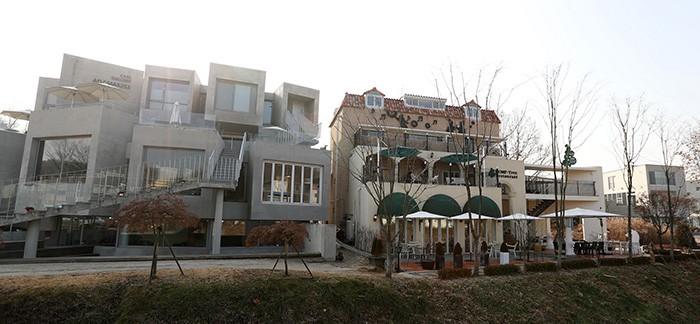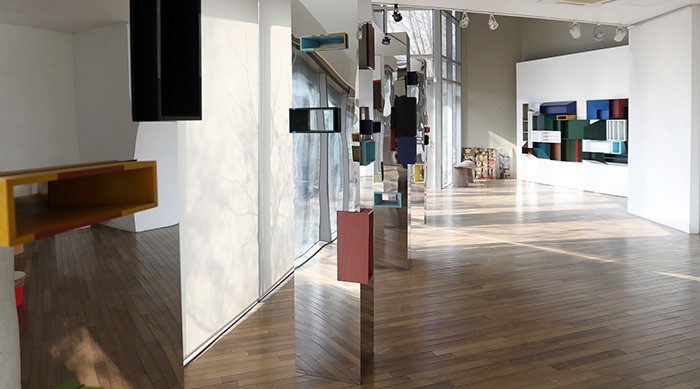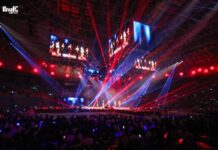Northwest of the capital city, nestled between two mountains in Paju, Gyeonggi-do Province, sits a special village devoted to the cultivation of the arts.
The Heyri Art Valley was founded in 1998 by a group of like-minded artists who wanted create a specialized community where art would be spoken as the common language. Today, the town is home to artists from all walks of life from a variety of artistic genres, with exhibitions and work spaces inviting visitors to enter and listen in on conversations that shed light on international art trends.

Cha Myung-Hi, a resident artist at Studio White Block, stands beside her current work-in-progress. The artist, primarily known for her black and white abstract paintings, will be exhibiting her work at Heyri’s White Block Art Center at the end of the year.
Currently, around 380 artists, including painters, architects, writers and musicians, are members of the Heyri Art Valley network. Some artists live on the property, while others have studios there, and all members collaborate on various projects throughout the year.
Walking along the village’s winding streets you’ll find some 16 galleries and 21 museums that showcase contemporary art, as well as sculptures, pottery, art deco furniture, jewelry and even folk instruments from around the world. During the annual open studio period, visitors can walk into private studios and talk to the artists about their work, to better understand the inspiration behind each of the featured artworks. The annual Pan Art Festival and the Art Road 77 art fair, meanwhile, exhibit some of the latest works by new and veteran artists, alike. Live, outdoor performances by jazz, classical, folk and pop musicians add some flair to the program.
Even if you’re not artistically inclined, Heyri is one of those places that makes it easy to appreciate and enjoy art for art’s sake.

Heyri Art Valley is filled with eye-catching architecture, so regardless of which cafe you pick as your rest stop, there will be plenty to see outside the window.

Heyri Art Valley’s Lio Gallery exhibits decorative ‘living art’ objects, such as art deco furniture and 3-D structures.
Visiting the Heyri Art Valley, one gets the impression that it serves as a kind of cradle for the next generation of talent. The director of the Lio Gallery, Lee Mi Hye, who was one of the founding members of the town, shared this sentiment. “The annual Art Road 77 art fair is a program designed to discover young artists and nurture their creativity. Naturally, we at Heyri have made it our mission to support such up-and-coming artists,” she said. “This year, Lio Gallery, which specializes in art deco furniture and decorative ‘living art’ objects, will be participating in the art fair. We’re hoping to invite a number of artists to collaborate with us to showcase everything from outdoor furniture to smaller, interior design pieces.”
Bigger art galleries are also on board with this mission. The White Block Art Center, centrally located by the reed park, is devoted to uncovering new talent, as well. The art center, divided into six exhibition rooms, showcases artworks by artists from around the world while also managing a residency program for up-and-coming professionals. White Block Studio, located some 200 meters from the art center, houses studio spaces where resident artists can work for up to one and a half years. Exhibition spaces, as well as opportunities to collaborate with the art center, are some of the additional perks of a residency.

The White Block Art Center is divided into six differently shaped exhibition halls, allowing artists to show their work in a space that suits their medium.

Painter Kim Sun Young, a resident artist at White Block Studio, works on her latest piece in her studio. The artist’s work focuses on finding ‘her place’ in the world, drawing inspiration from images of discarded objects.
Five resident artists currently occupy the work spaces at White Block Studio. Kim Sun Young, a resident artist based there until April 2018, seemed to think of her residency as a stroke of serendipity. “Really, it was the Heyri Art Valley that chose me,” she said, when asked why she had chosen this particular studio. “I’m enjoying being based in an art town, not only because I can take a walk outside, but the air is also quite clean. I’m receiving a lot of support from the art center and the community here.” The environment in which she works has manifested itself in her artwork, too. “From Paju, you can see both the Heyri Art Valley and catch a glimpse of North Korea across the river. The stark contrast between the two places makes me think a lot about my own identity, and I’ve been trying to reflect those emotions in the work I create here,” she said.
Over the years, more and more artists have shown an interest in joining the resident artist community at Heyri Art Valley. “A number of overseas artists have inquired about our residency program, but we haven’t been able to accommodate them in our White Block Studio, as there are only a limited number of living facilities,” said Choi Seung On, a curator at the White Block Art Center. “We’re actually in the process of building a new residency facility in Cheonan, Chungcheongnam-do Province, that can accommodate up to 16 live-in artists. The new facility will make it possible for us to invite overseas artists and give them an opportunity to find inspiration for their artwork here in Korea.”
By Lee Hana
Korea.net Staff Writer
Photos: Jeon Han, Korea.net Photographer
hlee10@korea.kr

The interior of the White Block Art Center features sleek lines in a well-lit space illuminated by natural sunlight. Through the tall windows, visitors can admire a view of the reed park and the neighboring galleries and museums.























